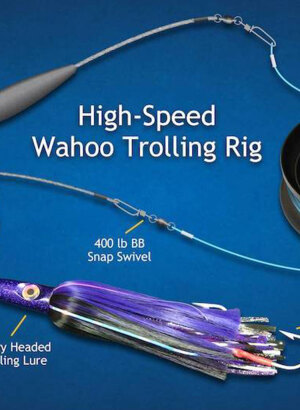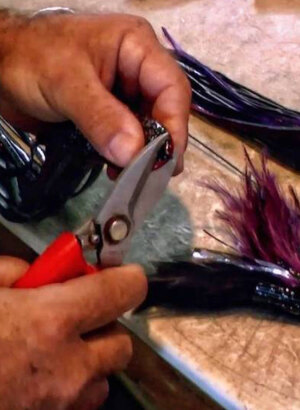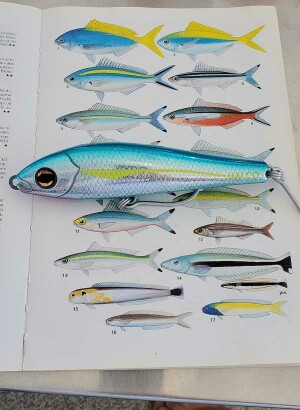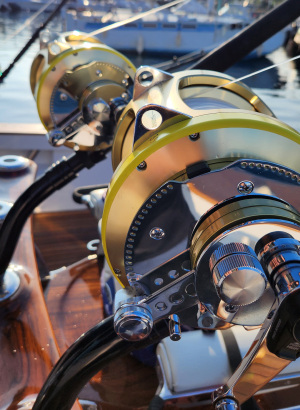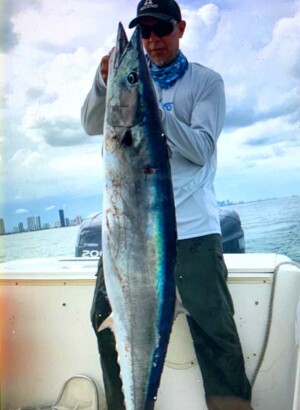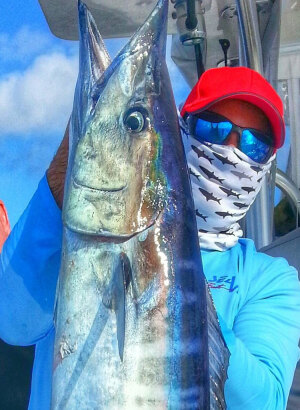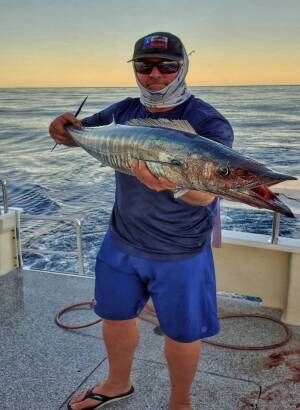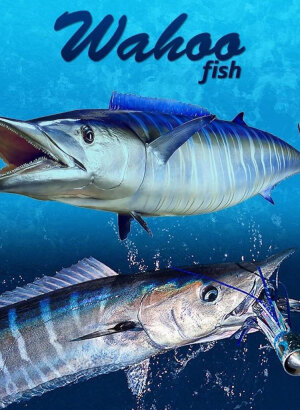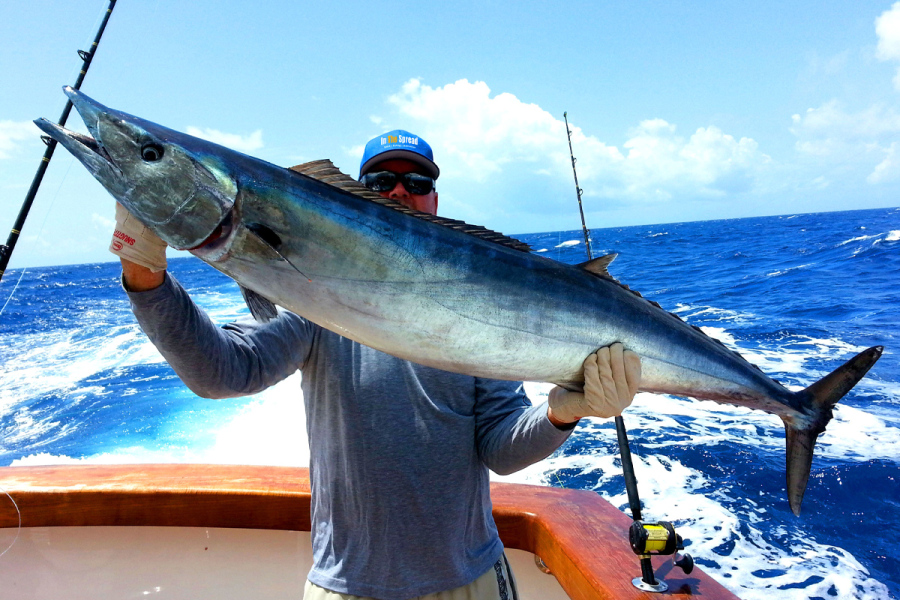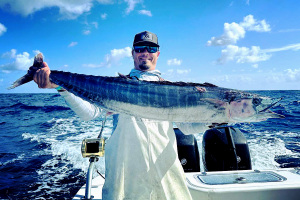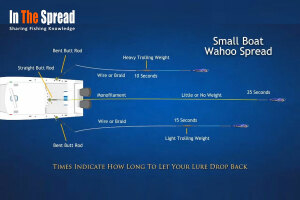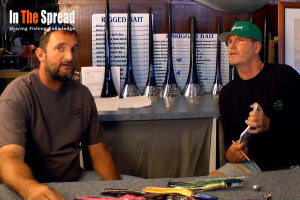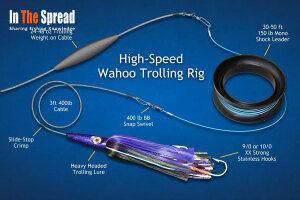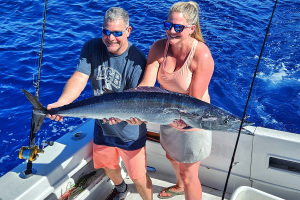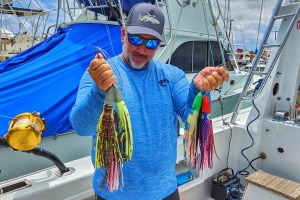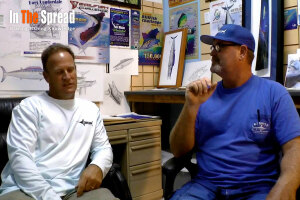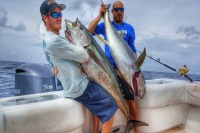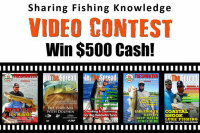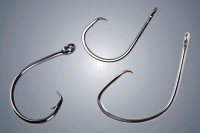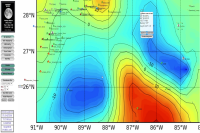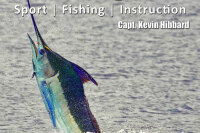Wahoo fishing occurs globally in tropical and subtropical waters of the Atlantic, Pacific, and Indian Oceans. These ferocious predators, known for their large mouths and strong teeth, are solitary hunters with tenacious feeding habits. They aggregate in productive feeding areas, searching for ideal water conditions and forage concentrations.
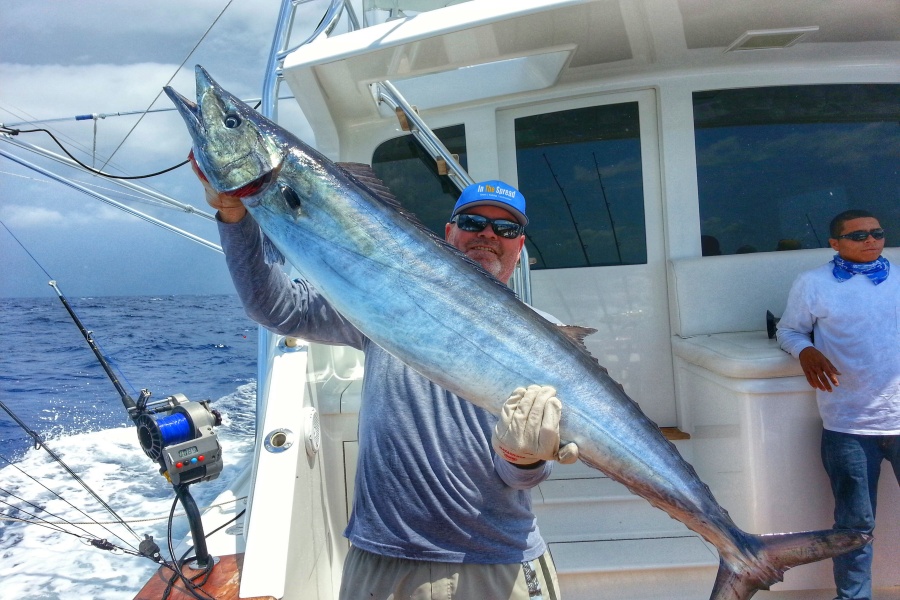
Wahoo Fishing - Ultimate Guide
Wahoo fishing takes place worldwide in the tropical and subtropical waters of the Atlantic, Pacific and Indian Oceans. The variety of tactics, techniques and amount of gear used to target wahoo is astonishing, the more you learn about targeting this species. Wahoo are ferocious predators, predominantly operating as solitary hunters, lone assassins, if you will. Possessing large mouths with strong, triangular, compressed, and finely serrated teeth means this is not a gamefish to be taken lightly. Their tenacious feeding habits, missile shaped muscular bodies, breathtaking speed and voracity with which they strike both bait and lure, makes wahoo fishing a pretty damn serious undertaking. The two pronged trick is to first locate fish and then making presentations that they will take. Mix this with the fact that wahoo will stage at almost any depth in the water column above the thermocline and you have pretty darn good fishing challenge on your hands.
Even though wahoo are known as loners, they will aggregate in productive feeding areas as small hunting packs, when ideal conditions and an abundance of forage exists. All of this is predicated on water temperature. Wahoo spend much, if not all, of their lives searching out ideal bands of water, where the right temperature and concentrations of forage merge. Much of this happens around some sort of structure.
Wahoo tend to cruise along the top and edges of drop offs in 20-100 fathoms where significant temperature and color breaks collide with the coastal shelf and canyon edges. Here they will mainly prey on other pelagic fish, smaller bullet and frigate tuna, dolphinfish, king and Spanish mackerels, jacks, pilchards, scads, butterfish, flying fish, herrings and squid.
Wahoo Aggregation Spots
Wahoo thrive in the blue water habitat, where ocean currents are ever changing. Within that space, two primary factors are keenly associated with the hunting grounds of wahoo; structure and water temperature. While structure is critical, water temperature plays a significant role in the action you encounter offshore. In the absence of any physical structure, water temperature serves as an aggregator. If you can isolate the convergence of structure and an ideal temperature break, the presence of wahoo is highly probable.
In your trip planning with the use of satellite data, key on color changes around drop-offs, rises on the bottom along the edge of the continental shelf and oil platforms, paying particular attention to where the current pushes over or up against structure creating upwellings that aggregate vast bait schools and other prey. It is highly recommended anglers pay close attention to their electronics for slight variances in bottom contour and temperature. It is so advantageous to know where ideal conditions exist before heading offshore.
In some areas of the world, wahoo fishing takes place adjacent to reef structure in and around islands, atolls or shelf edges. In places like this, tidal movements play are tremendous roll in where fish aggregate and the times of day when you can expect heavy feeding.
Wahoo Fishing Structure
The structure that wahoo are attracted to varies across the realm of your imagination. You can categorize wahoo fishing structure as either natural or man made it. Both provide a broad spectrum of opportunities for nice hoo action. Anything that will hold or motivate the movement of sea life can be the hunting grounds of wahoo.
Water pushing to the surface is called upwelling. When this happens, all sorts of bait and sea life is forced to the surface, where pelagic fish feed on it. Altimetry charts or satellite maps show the differences in wave heights or upwelling. You will have areas where the surface is higher or lower, based on upwelling or downwelling. Upwelling is where cooler nutrient rich waters are pushed up from the deep. These waters are loaded with phytoplankton and zooplankton, which are the building blocks of the food chain. Squid and all sorts of bait fish feed on this food source. In turn, bigger pelagic species, like wahoo, are drawn to these areas of upwelling to feast on the populations of baits fish. The edges of these upwellings, as indicated on altimetry maps, are generally the best to fish.
Sargasso habitat, weed lines, grass mats and floating debris amass in ocean currents around the world. Ocean weed or grass makes for great fishing, as it provide both shelter and a source of food for small bait fish. The smallest sea creatures thrive in the Sargasso grass, providing steady food for all makes of small fish. This in turn attracts larger fish and predators like wahoo. Floating debris or jetsam, while not as dynamic in the amount of life it supports, is another great type of structure to investigate. Many times, trigger fish or other species will use jetsam as the only source of protection in an otherwise wide open ocean. Wahoo will typically suspend down deep under the grass or debris waiting for the right moment to smash prey.
Temperature breaks are another form of structure. Breaks usually form vertical barriers that congregate baitfish. If you can find a break near physical structure that would be an optimum starting point. Work both sides of the break as your target may feed on one side while residing on the other. Not all temp breaks will be vertical walls, some will be just big enough to attract forage and thus predators in an otherwise desolate stretch of open water. You can use your satellite mapping service to locate ideal water temperatures and the edges or break lines where wahoo will feed.
When it comes to artificial structure or man-made, the oceans are loaded with objects that from the backbone for the building blocks of the food chain. Just like natural structure, man-made formations in the water over time develop algae and then barnacles, crabs, starfish and mussels will begin to congregate. Small fish are drawn to these easy pickings and from there, bigger and bigger fish move in. This environment is ripe for pelagic predators.
Some of the more obvious types of wahoo fishing structure are wrecks and oil platforms. Deep wrecks and offshore rigs are among the most productive fish habitats in the world. Wrecks and oil platforms provide marine wildlife with food, shelter from predators and a safe breeding ground.
Offshore oil rigs and drill ships are known to have monster wahoo lurking nearby. Rigs offer a feature rarely found in open water: their considerable height. These platform acts as a pinnacle and allows fish to move into deeper water as they mature, without having to leave their habitat. If you have ever seen underwater footage of expansive wrecks or oil platforms, you know very well how much life exists on these structures.
Buoys and FADS (fish aggregating devices) are another excellent source of outstanding wahoo fishing action. As they and their extensive mooring apparatuses become barnacle encrusted, a wide array of game fish set up shop, making them superb hunting waters for wahoo.
Water Temperature for Wahoo
Wahoo are found around the world in tropical waters year-round, but are also found in subtropical waters and even higher latitudes during the summer. If there was one motivating factor for how wahoo behave it would be water temperature. This is a water temperature driven fish. The reason for this never ending quest to inhabit warmish water is that wahoo do not have the ability to regulate their body temperature.
Virtually all of a wahoo's time is, daytime or nighttime, is spent above the thermocline in the epipelagic zone. This is the uppermost layer of ocean water where sunlight can penetrate. This layer interacts with the wind and waves, which mixes the water and distributes the warmth. At the base of this layer is the thermocline. Photosynthesis is possible in this zone. The majority of marine flora and fauna are within this region and that is where much of the prevailing baitfish reside. This region has ambient temperatures ranging from 60⁰F to 86⁰ F (20⁰C to 30⁰C) depending on the geographic location. The thermocline is the transition layer between the warmer mixed water at the surface and the cooler deep water below.
Research shows wahoo spend 90% of their time in water between 64˚F and 82˚F. Being able to isolate the water temperature range that wahoo find most suitable greatly helps in locating areas of open ocean to start searching within. I cannot stress enough the importance of focusing on the warm, upper mixed layer for the wahoo.
Wahoo can be scattered throughout coastal waters year round, but in the winter will migrate in search of milder water in the mid 70's, with an abundant presence of forage. Since the temperature of the Gulf Stream remains rather constant, finding an eddy drawing the current’s warmer, nutrient-rich water close to the continental shelf is bound to pay dividends. More successful anglers review sea surface temperature charts and satellite images of the Gulf Stream to identify temperature breaks and eddies.
Even during January and February when inshore water temperatures plummet the Gulf Stream remains relatively consistent, holding around 78 degrees. While this may be ideal water for wahoo fishing, locating a temperature break from 68 to 72 degrees is a major coup. You will usually find these preferred water boundaries along the edges of major current systems. In the gulf stream, wahoo have a tendency to hunt along the eastern edge in the winter and the inshore or western edge of the stream during the warmer waters of summer.
Before heading out and burning excessive amounts of fuel, utilize a high quality satellite mapping service to assess water temperatures closely to make sure locate and isolate optimal fishing grounds. Study these maps. Look for counter-rotating eddies of water pulling filaments of the nutrient rich over bottom structure like the coastal shelf and canyon edges , further condensing forage and predator fish.
If you want to learn more about the use of Satellite Maps to locate ideal wahoo fishing waters, check out the following videos on sea surface temperature, chlorophyll, altimetry.
Learn Wahoo Fishing Tactics and Techniques
Wahoo Fishing Techniques
When it comes to wahoo fishing techniques, there are a multitude of methods by which these fish can be captured with relative consistency. Since this species moves up and down in the water column based on where the bait is holding, you really need to be versed in multiple of tactics.
Depending in the depth at which the wahoo are suspending or feeding will determine your tactical approach. Fish don’t just stay near the surface, especially when there’s a strong thermocline or strong temperature break beneath the surface. The next key to where wahoo will be found in the water column is the position of the bait. Always look for bait and the thermocline. A lot of the time the bait schools and the thermocline will be at about the same depth. Where the vertical temperature change takes place will be the depth where the fish gather. You can easily locate the thermocline with your electronics.
If there are strong indications of bait near the surface or if you are fishing tight to a reef, high speed trolling pattern may be the best option. Given the nature of wahoo to be on the move the ideal water or food, searching for fish may be required, especially in more open water. A high speed pattern will allow you to cover a lot more area and increase the possibility of encountering wahoo.
When you know there are wahoo in the general area you are trolling or fish down in the water column, then a low-speed trolling pattern may work best. Some lipped or bibbed trolling lures will dive deep, but not as deep as a planer or downrigger will get baits. You absolutely must make your presentation at the depth where the fish are staging.
Bait spreads and positioning really are a matter of preference and confidence. Fishermen tend to lean in the direction of their confidence. If you feel comfortable with one particular fishing technique, that will probably be how you fish for wahoo. Of course, with the more experience you have, conditions and knowing what pulls best behind a given boat considering wind, the sea and the speed all play into your decision making.
High Speed Trolling Wahoo
It seems like the go to wahoo fishing technique is high speed trolling. Wahoo are super fast, so ripping lures through the water makes sense. It's exciting. Everyone, well, almost everyone, seems to enjoy hauling ass around dragging lures in wait for reel screaming action.
The one thing that is for sure is that if you want to cover ground or work an area to locate fish, high speed trolling is super effective. I mean, that is the major benefit. You can cover a lot more water than you would be able to if you were dragging natural baits, which will wash out very quickly at speed. Higher speeds will also help avoid barracuda and other non-targeted fish.
At speeds of 12-20 knots or more, lures have a tendency to swim up to the surface. That doesn't work real well for wahoo fishing. These guys are sight feeders, preferring to take prey from below, so if your lures are bouncing around on the surface, you may not get a lot of bites. That is why the lures and rigs are heavily weighted to keep them down in cleaner water just below the surface and out of the prop wash.
The basic high speed technique entails trolling a four to five line spread of bullet and jet shaped lures through the water with the use of 16- to 48-ounce trolling leads and lengthy shock leaders. Some fishermen will high speed troll until they find concentrations of hungry wahoo, at which point they pull back the throttles and swap out trolling lures for horse ballyhoo and strip baits rigged with sea witches and Iland Lures. This style of fishing is very popular along the east coast of Florida, the Gulf of Mexico and throughout the Caribbean.
Our comprehensive video on High Speed Trolling for Wahoo shares the fundamentals you need to be a damn good wahoo fisherman.
Slow Trolling Wahoo
The one obvious reason to slow troll baits deeper in the water column is that wahoo have a proclivity for hanging at depth where the bait schools reside. In this regard, slow trolling with planers is highly effective in getting offerings well below the surface where the fish are holding.
Slow trolling speeds hover around 6 to 10 knots. You just cannot pull skirted dead baits much faster and if you are fishing planers, you really cannot go very fast. A slow and consistent troll is needed to take advantage of the scent and natural swimming action of the fresh baitfish.
With slow trolling for wahoo, you typically will have a planer of two in the water with down baits, as well as rigger baits and these baits must be checked somewhat frequently to ensure you still have a tasty morsel on the hook. Wahoo will cut you baits off and if you are pulling hooks without baits, you are out of the game. Slow trolling, in that regard, is a bit more labor intensive. You could debate that slow trolling in more technical, as well. Perhaps, that is why more fishermen don't do it. But, don't kid yourself. Slow trolling for wahoo is very productive when executed properly.
A typical slow trolling spread may include 1-2 planer rods, a flat line if you are only pulling one planer, 2 short rigger rods and 2 long rigger rods. A shotgun lure is often times run way back. With the planer rods, No. 8 or No. 16 planers are common. The size of you planer is determined by the temperature. When it is hotter, the deeper you should fish, because the wahoo will suspend at greater depth. The deeper the fish, the bigger or heavier your planer.
I suggest your planer to be run about 75 feet back. You want it to be running below the prop wash. The flat line should be set about 100 feet, the left short rigger 150 feet, the right short rigger 200 feet, the left long rigger 250 feet and the right long rigger 200 feet. These numbers are not set in stone and you should experiment with what works for your boat. A good rule of thumb is to try and get all your baits or lures into clean water, away from the prop wash. This will give the wahoo a clear channel to see and attack your presentations. Your shotgun lure can be back there 350 or more.
DownRiggers for Wahoo
At times, wahoo will suspend well below the depth at which a planer will reach and will simply refuse to move up through the water column. How do you trigger bites in this scenario? Presenting baits at the level where the wahoo are suspending is the answer. The one device that will get you way down is a downrigger. With a downrigger, you can pull a simple but effective lure, such as a Drone spoon, right past the fish, no matter the depth.
Downriggers must be properly tended. When you get a fish on the line, you need to get the downrigger ball up and out of the way fast or you risk a tangled up disaster and no fish. Another word of caution would be to replace the usual down rigger cable with 200-pound braid line to prevent humming while you slowly troll around.
Boat Driving
Driving the boat along the edge is an exact science, if you want to catch more fish. Your lures need to be in the right depth. Go too deep and catch nothing. Get to shallow and it's barracudas. The makeup of the edge is rather steep. The distance from the shallow part of the reef to the deeper water is short. The edge is hard, but this is where you need to be.
If you are not driving, weaving your way along the edge, you are not catching wahoo. Since the edge is not straight, you will not be driving in a straight line. The thing you have to recon is what depth are your lures as you work your way along the edge. They will go from deep to shallow and back again. It is not the depth under you boat that you have to factor in. It is where your lures are.
Understanding where along the edge wahoo will position themselves is key to knowing where you should concentrate your wahoo trolling spread.
Learn more about boat driving with the video edge trolling for wahoo.
If you want to learn more about wahoo fishing in general, rigging wahoo lures, terminal tackle, setting up trolling spreads, trolling techniques or more, check out our library of Wahoo Fishing Videos. We also have an ample amount of wahoo fishing articles on various other techniques in our blog.

